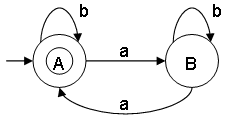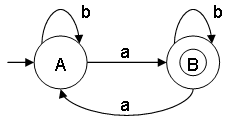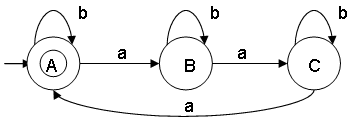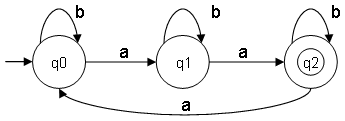Construction of minimal DFA
Information on this page based on: YouTube: Theory Of Computation 2, Construction of minimal DFA and problems
- Construct a minimal DFA that accepts set of all strings over {a,b} of length 2
ω ∊ {a,b} and |ω| = 2
Σ = {a,b}
L = {aa,ab,ba,bb}
This DFA is NOT corect. It does accept set of all strings over {a,b} of length 2, but it should also reject
strings of other lengths for example: {a,a,a}

This DFA is corect. It does accept set of all strings over {a,b} of length 2 and rejects strings of other lengths for example: {a,a,a}

When is the string accepted:
The string is accepted by the FA if we are able to reach a final state starting from the initial state
upon scanning the entire string.
When is the language accepted:
The language is accepted by the FA if all strings in the language are accepted.
All strings not in the language are rejected.
Notes:
- A FA can have more than 1 final state.
- State D is also called the dead or trap state.
- This minimal DFA has 4 states and state C (also referred as q2) is the final state.
- The language L is finite which means the FA is finite (= finite number of states).
- Construct a minimal DFA that accepts set of all strings over {a,b} of length 2 or more
ω ∊ {a,b} and |ω| >= 2
L = {aa,ab,ba.bb,aaa, ..., bbb, ...}

Notes:
- For a language L you can draw many DFA diagrams, but there is only 1 minimal DFA.
The word "minimal" refers to the minimal number of states used.
- The language L is infinite, we do not know if the FA is finite or infinite.
By drawing the FA diagram there are a finite number of states which means this minimal DFA is finite.
- State A represents set of all strings of length 0.
- State B represents set of all strings of length 1.
- State C represents set of all strings of length 2.
- This minimal DFA has 3 states and state C (also referred as q2) is the final state.
- Construct a minimal DFA that accepts set of all strings over {a,b} of length 2 or less
ω ∊ {a,b} and |ω| <= 2
L = {ε,a,b,aa,ab,ba,bb}

Notes:
- For a language L you can draw many DFA diagrams, but there is only 1 minimal DFA.
The word "minimal" refers to the minimal number of states used.
- The language L is finite which means the FA is finite (= finite number of states).
- State A represents set of all strings of length 0.
- State B represents set of all strings of length 1.
- State C represents set of all strings of length 2.
- State D represents set of all strings of length 3 or more which will be rejected.
- If you have ε, always make the inital state a final state.
- This minimal DFA has 4 states and states A, B and C (respectively referred as q0, q1, q2) are the final states.
- Number of states required in a minimal DFA that accepts set of all strings with a certain length
In general a minimal DFA accept strings of length n requiring the following the number of states:
ω ∊ {a,b}
|ω| = n, number of states required: (n+2)
|ω| >= n, number of states required: (n+1)
|ω| <= n, number of states required: (n+2)
- Construct a minimal DFA that accepts set of all strings over {a,b}, where the length modulo 2 = 0
ω ∊ {a,b} and |ω| mod 2 = 0
L = {ε,aa,ab,ba,bb,aaaa,bbbb,...}

Notes:
- Even length strings satisfies the condition: |ω| mod 2 = 0
- ε is a string of length 0 and |ε| mod 2 = 0
- The language L is infinite, we do not know if the FA is finite or infinite.
By drawing the FA diagram there are a finite number of states which means this minimal DFA is finite.
- |ω| mod 2 = 0 can also be written as |ω| ≅ 0 (mod 2). The symbol ≅ means congruent.
- State A represents set of all strings of even lengths.
- State B represents set of all strings of odd lengths.
- This minimal DFA has 2 states and state A (also referred as q0) is the final state.
- Construct a minimal DFA that accepts set of all strings over {a,b}, where the length modulo 2 = 1
ω ∊ {a,b} and |ω| mod 2 = 1
L = {a,b,aaa,aab,...}

Notes:
- Odd length strings satisfies the condition: |ω| mod 2 = 1
- ε is a string of length 0 and does not satisfy condition |ε| mod 2 = 1
- The language L is infinite, we do not know if the FA is finite or infinite.
By drawing the FA diagram there are a finite number of states which means this minimal DFA is finite.
- |ω| mod 2 = 1 can also be written as |ω| ≅ 1 (mod 2). The symbol ≅ means congruent.
- State A represents set of all strings of even lengths.
- State B represents set of all strings of odd lengths.
- This minimal DFA has 2 states and state B (also referred as q1) is the final state.
- Construct a minimal DFA that accepts set of all strings over {a,b}, where the length modulo 3 = 0
ω ∊ {a,b} and |ω| mod 3 = 0
L = {ε,aaa,aab,aaaaaa,...}

Notes:
- Strings with lengths 0, 3, 6, 9, ... satisfies the condition: |ω| mod 3 = 0
- ε is a string of length 0 and does satisfy condition |ε| mod 3 = 0
- The language L is infinite, we do not know if the FA is finite or infinite.
By drawing the FA diagram there are a finite number of states which means this minimal DFA is finite.
- |ω| mod 3 = 0 can also be written as |ω| ≅ 0 (mod 3). The symbol ≅ means congruent.
- State A represents set of all strings of length 0, 3, 6, 9, ....
- This minimal DFA has 3 states and state A (also referred as q0) is the final state.
- Construct a minimal DFA that accepts set of all strings over {a,b}, where the length modulo 3 = 1
ω ∊ {a,b} and |ω| mod 3 = 1
L = {a,b,aaaa,aaab,...}

Notes:
- Strings with lengths 1, 4, 7, 10, ... satisfies the condition: |ω| mod 3 = 1
- ε is a string of length 0 and does not satisfy condition |ε| mod 3 = 1
- The language L is infinite, we do not know if the FA is finite or infinite.
By drawing the FA diagram there are a finite number of states which means this minimal DFA is finite.
- |ω| mod 3 = 1 can also be written as |ω| ≅ 1 (mod 3). The symbol ≅ means congruent.
- State B represents set of all strings of length 1, 4, 7, 10, ....
- This minimal DFA has 3 states and state B (also referred as q1) is the final state.
- How many states are in a minimal DFA that accepts set of all strings over {a,b}, where the length modulo n = 0
ω ∊ {a,b} and |ω| mod n = 0
Answer: The number of states is n
For example:
ω ∊ {a,b} and |ω| mod 2 = 0 -> number of states = 2
ω ∊ {a,b} and |ω| mod 3 = 0 -> number of states = 3
ω ∊ {a,b} and |ω| mod 4 = 0 -> number of states = 4
ω ∊ {a,b} and |ω| mod 5 = 0 -> number of states = 5
ω ∊ {a,b} and |ω| mod 6 = 0 -> number of states = 6
:
- Construct a minimal DFA that accepts set of all strings over {a,b}, where the number of "a" are 2
ω ∊ {a,b} and na(ω) = 2
L = {aa,baa,aab,aba,aabb,bbaa,bbbaa,...}

Notes:
- The language L is infinite, we do not know if the FA is finite or infinite.
By drawing the FA diagram there are a finite number of states which means this minimal DFA is finite.
- State A represents set of all strings of length 0
- State B represents set of all strings of length 1
- State C represents set of all strings of length 2
- State D (dead state) represents set of all strings of length 3
- This minimal DFA has 4 states and state C (also referred as q2) is the final state.
- Construct a minimal DFA that accepts set of all strings over {a,b}, where the number of "a" are at least 2
ω ∊ {a,b} and na(ω) >= 2
L = {aa,aaa,baa,aab,aba,aaab,aabb,bbaa,bbbaa,aaabb,...}

Notes:
- The language L is infinite, we do not know if the FA is finite or infinite.
By drawing the FA diagram there are a finite number of states which means this minimal DFA is finite.
- State A represents set of all strings of length 0
- State B represents set of all strings of length 1
- State C represents set of all strings of length 2
- This minimal DFA has 3 states and state C (also referred as q2) is the final state.
- Construct a minimal DFA that accepts set of all strings over {a,b}, where the number of "a" is 2 or less
ω ∊ {a,b} and na(ω) <= 2
L = {ε,a,b,aa,ab,ba,bb,aab,aba,baa,aabb,aabbb,...}

Notes:
- The language L is infinite, we do not know if the FA is finite or infinite.
By drawing the FA diagram there are a finite number of states which means this minimal DFA is finite.
- State A represents set of all strings of length 0
- State B represents set of all strings of length 1
- State C represents set of all strings of length 2
- State D (dead state) represents set of all strings of length 3
- This minimal DFA has 4 states and state A, B and C (respectively referred as q0, q1 and q2) are the final states.
- Construct a minimal DFA that accepts set of all strings over {a,b}, where the number of "a" is even
ω ∊ {a,b} and na(ω) mod 2 = 0
L = {ε,b,aa,aab,aba,baa,aaaab,aababab,...}

Notes:
- The language L is infinite, we do not know if the FA is finite or infinite.
By drawing the FA diagram there are a finite number of states which means this minimal DFA is finite.
- na(ω) mod 2 = 0 can also be written as na(ω) ≅ 0 (mod 2). The symbol ≅ means congruent.
- State A represents set of all strings of length 0, 2, 4, 6, 8,... (even lengths)
- State B represents set of all strings of length 1, 3, 5, 7, 9,... (odd lengths)
- This minimal DFA has 2 states and state A (also referred as q0) is the final state.
- Construct a minimal DFA that accepts set of all strings over {a,b}, where the number of "a" is odd
ω ∊ {a,b} and na(ω) mod 2 = 1
L = {a,ab,abb,abaa,aaab,aabaaa,ababab,...}

Notes:
- The language L is infinite, we do not know if the FA is finite or infinite.
By drawing the FA diagram there are a finite number of states which means this minimal DFA is finite.
- na(ω) mod 2 = 1 can also be written as na(ω) ≅ 1 (mod 2). The symbol ≅ means congruent.
- State A represents set of all strings of length 0, 2, 4, 6, 8,... (even lengths)
- State B represents set of all strings of length 1, 3, 5, 7, 9,... (odd lengths)
- This minimal DFA has 2 states and state B (also referred as q1) is the final state.
- Construct a minimal DFA that accepts set of all strings over {a,b}, where the number of "a" modulo 3 = 0
ω ∊ {a,b} and na(ω) mod 3 = 0
L = {ε,aaa,aaba,aaab,aaabb,aaaaaa,...}

Notes:
- Strings with lengths 0, 3, 6, 9, ... satisfies the condition: na(ω) mod 3 = 0
- ε is a string of length 0 and does satisfy condition na(ω) mod 3 = 0
- The language L is infinite, we do not know if the FA is finite or infinite.
By drawing the FA diagram there are a finite number of states which means this minimal DFA is finite.
- na(ω) mod 3 = 0 can also be written as na(ω) 0 (mod 3). The symbol ≅ means congruent.
- State A represents set of all strings where the length of "a" are 0, 3, 6, 9, ....
- This minimal DFA has 3 states and state A (also referred as q0) is the final state.
- Which state is the final state in a minimal DFA with N states that accepts set of all strings over {a,b}, where the number of "a" modulo N = k
ω ∊ {a,b} and na(ω) mod N = k and N = number of states
Answer:
Number of states = N and ω ∊ {a,b} and na(ω) mod N = k -> final state = qk
Number of states = N and ω ∊ {a,b} and na(ω) mod N = 0 -> final state = q0
Number of states = N and ω ∊ {a,b} and na(ω) mod N = 1 -> final state = q1
Number of states = N and ω ∊ {a,b} and na(ω) mod N = 2 -> final state = q2
Number of states = N and ω ∊ {a,b} and na(ω) mod N = 3 -> final state = q3
:
For example:
Number of states = 3 and k = 2
ω ∊ {a,b} and na(ω) mod 3 = 2
L = {aa,aaaaa,aaaaaaaa,aabb,baaaaa,...}
Final state = q2

For example:
Number of states = 4 and k = 1
ω ∊ {a,b} and na(ω) mod 4 = 1
L = {a,aaaaa,aaaaaaaaa,ab,aabaaa,...}
Final state = q1

|















